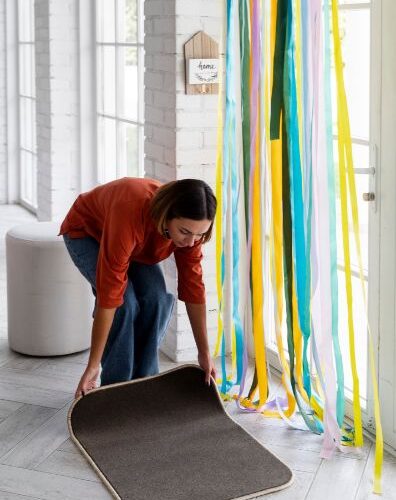Table of Contents Show
Dive deep into the world of yoga mats – how to fix a torn yoga mat, when to replace them, and how to keep them lasting longer. From DIY repair tips to choosing the right mat, this guide has it all! Join us on this journey of yoga mat enlightenment.
Ah, the yoga mat. That sacred space where we find peace, flexibility, and occasionally, an unexpected tear. If you’ve ever been deep into a downward dog only to discover your mat is ripping apart beneath you, you know the horror. But fear not, for I shall guide you through the perils of a wounded mat.
Disclosure: As an Amazon Associate I earn from qualifying purchases.
The Unexpected Rips and the Stories They Tell
You might wonder, “how did my yoga mat, the foundation of my zen space, betray me like this?” It’s much like seeing your favorite pair of jeans get its first accidental tear, a mix of disbelief and a little heartbreak. But like every scar, every tear has a story.
Well, yoga mats, like every cherished possession, are not immune to the passage of time. Factors like the type of material, the frequency of your yoga sessions, the level of those killer yoga moves, and even the way you store and maintain your mat play roles in its overall lifespan. And let’s not forget, sometimes the universe might just be telling you, “Hey, remember that Vinyasa flow last week? Yeah, that was intense!”
But let’s dive deeper. Flaking or tearing in yoga mats can result from:
- Material Makeup: Not all yoga mats are created equal. Some materials are more durable and resilient than others. While PVC mats might be prone to wear and tear, rubber and TPE mats tend to be sturdier.
- Frequency of Use: If you’re the kind of yogi who believes in daily dedication, your mat gets more action and naturally wears out quicker.
- Intensity of Practice: If you’re into power yoga or intensive Ashtanga sessions, your mat faces more friction, pressure, and stretch than with lighter practices.
- Storage & Maintenance: Mats left exposed to direct sunlight or stored in damp places can deteriorate faster. Also, folding a mat instead of rolling it might introduce weak points[3].
But before you toss your mat into the abyss of forgotten workout equipment, consider giving it a second chance. Because, how to fix a torn yoga mat? Ah! Let me count the ways.
How to Fix a Torn Yoga Mat: Repairing That Pesky Tear
So you’ve got that unwanted tear and you’re looking at it with furrowed brows, thinking, “Is there hope?” Spoiler alert: Yes, there is.
When faced with a tear, most of us have two initial reactions: panic or an insatiable urge to duct tape everything. But worry not, because a torn yoga mat isn’t the end of its life. With a little TLC, it can serve you for many more sun salutations.
- Assess the Wound: Before you dive into surgery mode, take a deep breath, and objectively examine the damage.
- Surface Scratch: Is it a minor scratch that’s more of an eyesore than an actual problem? These are often superficial and can be mended easily.
- Deep Gash: If the tear runs deep, affecting the mat’s functionality, then a more hands-on approach is required.
- Gather Your Tools: It’s time for a little DIY action. If your yoga mat tear had a villainous name, it’d fear the mighty SUPER BONDER 420 GLUED.
- Clean the Scene: Use a mild soap and water mix to clean around the tear. This ensures no dust or grime interferes with the adhesive. Dry thoroughly.
- Become One with the Adhesive: Apply the super adhesive cautiously, ensuring full coverage, but avoid overflowing it.
- Reunite the Separated: Press the torn edges together gently. No rush. Yoga is about patience, remember?
- Pressure is Key: Use a weight or a heavy book to keep the mat’s torn parts in contact. This ensures a firmer bond.
- Meditate… or Just Wait: Allow the adhesive to dry completely. This is crucial for the mat’s longevity.
For tiny, superficial tears, a simple home solution can also involve using clear tape as a temporary solution. Though not as enduring as adhesive, it can be a quick fix until you get the right adhesive.
If you’re worried about the mat’s appearance post-surgery, you can always use a stylish yoga towel on top. It not only masks the scar but adds an extra layer of cushioning and grip. Two birds, one stone!
But… Should I Even Fix It? Decoding The Tell-Tale Signs
Ah, the age-old debate of repair versus replace! It’s akin to mending that old sweater with memories attached, even though there’s a fancy new one in the closet. Here’s a deeper dive into assessing if your yoga mat is worth the stitches or if it’s time to bid adieu.
1. Sentiment vs. Safety
We get it; sometimes, the yoga mat isn’t just a piece of rubber or TPE. It’s been with you during your highs (like nailing that tricky pose) and lows (like almost face-planting during a failed balance pose). There’s a sentimental value. However, if the mat has lost its grip or if tears and wears compromise your balance, safety should always come first[1].
2. The Age Factor
As with many things in life, age can take its toll on a yoga mat. Typically, with daily use, a yoga mat will last about a year, maybe two if you’re lucky[5]. If it’s been with you longer than your last three relationships combined, perhaps it’s time to consider a new mat.
3. The Slippery Slope
A tear might be a glaring defect, but subtle signs can be just as alarming. If your mat becomes a sliding surface despite regular cleaning, it’s no longer serving its primary purpose of providing grip[2].
4. Thin Lines between Love and Reality
You may not see actual holes, but thinning areas, especially under high-stress zones (like where your hands and feet usually land), can be precursors to a tear. Besides, a thin mat can be less supportive and more painful for the joints during specific poses[1].
5. The Smell Saga
Sometimes, the damage isn’t visible. If there’s a persistent odor even after cleaning, it might indicate bacterial or fungal growth. This isn’t just unpleasant; it can be a health hazard. So, if your mat smells like it ran a marathon without you, it’s a sign[1].
Choosing the Right Mat: A Love Story
Ever been on a blind date and instantly knew it wasn’t going to work out? The same can be said about yoga mats. Sometimes, they just aren’t the right fit—literally. The quality of your mat can directly influence your practice, so choosing wisely is vital.
- Grip Matters: The days of sliding in the middle of a challenging pose are over! Depending on the material, some mats offer a better grip. Rubber, TPE, and polyurethane are like the knights in shining armor of the yoga mat world, ensuring your warrior pose remains unyielding[2].
- New Mat Slipperiness: If you’ve ever felt betrayed by a brand-new mat’s slipperiness, you’re not alone. Some new mats have a surface film from manufacturing which makes them slick initially. Think of this as their “teenage phase,” which they’ll eventually outgrow[4].
- Breaking In: Use your mat regularly, and it’ll naturally lose its slippery sheen. Just like how wine gets better with age, your mat’s grip improves as you use it more.
- Sunbathing Helps: Letting your mat lie flat in indirect sunlight can reduce its initial slipperiness. But remember, direct sunlight can harm its material.
- The Balance Between Thickness and Portability: Too thick, and it feels like you’re on a marshmallow. Too thin, and you feel every floor grain. Find a mat that provides enough cushioning without compromising on stability.
- Eco-Friendly Choices: Given that we practice yoga to align ourselves with nature and the universe, why not choose a mat that aligns with this philosophy? There are numerous eco-friendly yoga mats available which are both sustainable and provide excellent functionality.
Remember, your mat is more than just an accessory. It’s your partner in every stretch, bend, and pose. Choose wisely and let the love story begin!
Keep It Clean, Keep It Long: The Deep Dive
Regular maintenance of anything you love is a silent declaration of that affection. Think of your yoga mat as a beloved pet. Just as you’d groom your dog, bathe your cat, or clean your parrot’s cage, your yoga mat too demands tender love and care. Let’s get into the nitty-gritty of keeping that mat of yours in pristine condition.
Why Cleaning is Essential
- Germs and Bacteria Be Gone: Our body, especially during a sweaty session of sun salutations, sheds. We leave behind dead skin cells, oils, and sweat. Over time, this creates a veritable paradise for bacteria, fungi, and germs[1].
- Odor Management: A consistent cleaning regimen ensures your yoga mat doesn’t start to emanate that stale, musty smell which can distract from the serene atmosphere you’re trying to create during your practice.
- Traction and Grip: The build-up of dirt and oils can make your mat slippery. Cleaning restores the grip and ensures your crow pose doesn’t inadvertently turn into a faceplant pose.
The Right Way to Clean
- Choose the Right Cleanser: Depending on your mat’s material, the choice of cleanser varies. A simple solution of water and mild soap often does the trick. There are also specialized yoga mat sprays available in the market.
- Frequency Matters: If you’re an everyday yogi, a weekly deep clean coupled with a post-practice wipe down is ideal.
- Air Dry After Cleaning: After cleaning, let your mat dry in a shaded spot. Direct sunlight might degrade certain mat materials.
In Conclusion: To Mend or To End?
To answer the question of how to fix a torn yoga mat, it’s a blend of assessing the damage, knowing how to repair, and understanding when it’s time to let go. Yoga is all about balance, and the same goes for its equipment. Whether you’re mending the mat or deciding it’s time for a new one, ensure it adds to your practice, not distracts from it.
FAQs: The Yoga Mat Quandaries Solved!
Q1: How often should I clean my yoga mat?
A: Ideally, give it a light wipe-down after every practice to remove sweat and oils. Depending on the intensity of your workouts, a deeper clean can be done weekly or bi-weekly.
Q2: Can I just throw my yoga mat in the washing machine?
A: While it might seem like a quick solution, not all mats are machine-washable. Always check the care instructions. For many mats, especially those made of rubber or TPE, hand washing is recommended.
You May Also Like:
Q3: I’ve repaired my mat. Does this mean it’s good as new and will last forever?
A: Not quite. Repairing a tear or damage can extend your mat’s life, but it won’t reset the clock. Stay observant for any further wear and tear.
Q4: My mat has tiny flaky bits coming off. Is this normal?
A: Over time, especially with heavy use, yoga mats can begin to degrade, resulting in those tiny flakes. This is a clear sign that it’s time to invest in a new mat[3].
Q5: Is it eco-friendly to keep replacing yoga mats?
A: Great question! If sustainability is a concern, opt for eco-friendly yoga mats made from natural rubber, jute, or organic cotton. Also, instead of throwing away old mats, consider recycling them or repurposing them around the house.
You May Also Like: Can Yoga Mat Damage Your Feet?: Unraveling the Truth
Q6: I’ve noticed color fading on my mat. Is it still safe to use?
A: Color fading can be a result of UV exposure, especially if you love practicing outdoors. While it might not impact the functionality immediately, it’s a sign of the mat material degrading. Monitor the grip and texture; if it feels off, consider replacement.
Q7: Can I use regular household glue to fix a tear in my yoga mat?
A: While tempting, household glues might not provide the flexibility needed for a yoga mat repair. Furthermore, they might contain chemicals that can further degrade the mat. It’s always best to use recommended adhesives or yoga mat repair kits[3].
Q8: How do I know if a tear or hole is too big to repair?
A: If the tear affects the structural integrity of the mat or poses a tripping hazard, it’s likely too significant to mend effectively. In such cases, replacement is the wiser choice.
Q9: Do thicker mats wear out slower than thin ones?
A: Not necessarily. While thicker mats provide more cushioning, their durability largely depends on the material quality and usage frequency.
Q10: I’ve been gifted a used yoga mat. Should I be worried about hygiene?
A: It’s essential to give a used mat a thorough cleaning before your first practice. However, if the mat shows signs of excessive wear, thinning areas, or persistent odor, it might be safer and more hygienic to invest in a new one[5].





